| Dubai Metro | |
|---|---|
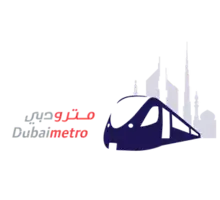 | |
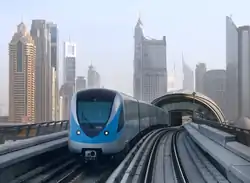 Dubai Metro train departing from Burj Khalifa/Dubai Mall station. | |
| Overview | |
| Native name | مترو دبي |
| Owner | Roads & Transport Authority |
| Locale | Dubai, United Arab Emirates |
| Transit type | Rapid transit |
| Number of lines | 2 (3 in 2029) |
| Number of stations | 53 (31 on red line, 20 on green line and 5 on branch line) (65 stations with 14 on blue line soon) |
| Daily ridership | 684,000 (2023) |
| Annual ridership | 249,660,000 (2023 Estimated) |
| Headquarters | Dubai Metro OCC |
| Website | www |
| Operation | |
| Began operation | September 9, 2009 |
| Operator(s) | keolis |
| Infrastructure manager(s) | Keolis-MHI Octopus Cards Limited |
| Train length | 5 |
| Technical | |
| System length | 89.6 km (55.7 mi) |
| No. of tracks | 2 |
| Track gauge | 1,435 mm (4 ft 8+1⁄2 in) standard gauge |
| Electrification | Third rail, 750 V DC[1] |
| Top speed | 95 kmph (59 mph) |
The Dubai Metro (Arabic: مترو دبي) is a rapid transit rail network in the city of Dubai, United Arab Emirates. It is currently operated by a consortium of the French company, Keolis, and Japanese Company, MHI (Mitsubishi Heavy Industries), as Keolis-MHI.[2]
The Red Line and Green Line are operational, with a major 15 km (9.3 mi) extension to the Red Line known as Route 2020 to the Expo 2020 site announced in April 2015 and opened in 2021. These first two lines run underground in the city centre and on elevated viaducts elsewhere.[3]
All trains are fully automated and driverless, and, together with stations, are air conditioned with platform edge doors. Architecture firm Aedas designed the metro's 45 stations, two depots and operational control centers.[4] The Al Ghurair Investment group were the metro's builders.[5]
The first section of the Red Line, covering 10 stations, was ceremonially inaugurated at 9:09:09 pm on 9 September 2009, by Mohammed bin Rashid Al Maktoum, Ruler of Dubai,[6] with the line opening to the public at 6 am (UTC 04:00) on 10 September.[7] The Dubai Metro is the first urban train network in the Arabian Peninsula[8] and either the second in the Arab World (after the Cairo Metro) or the third (if the surface-level, limited-service Baghdad Metro is counted).
More than 110,000 people, or nearly 10 percent of Dubai's population, used the Metro in its first two days of operation.[9] The Dubai Metro carried 10 million passengers from launch on 9 September 2009 to 9 February 2010 with 11 stations operational on the Red Line.[10] Engineering consultancy Atkins provided full multidisciplinary design and management of the civil works on Dubai Metro.[11][12]
Until 2016, the Dubai Metro was the world's longest driverless metro network with a route length of 75 kilometres (47 mi), as recognized by Guinness World Records in 2012.[13] The system was surpassed by the Vancouver SkyTrain in 2016 for the longest fully automated system in the world but regained the title in 2021 with the opening of Route 2020. However, its total route length have since been surpassed by the automated lines of the Singapore MRT. Nevertheless, the Red Line, at 52.1 kilometres (32.4 mi), remains the world's longest driverless single metro line.[14]
Construction

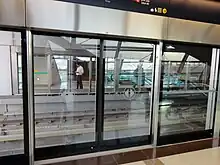
Planning of the Dubai Metro began under the directive of Dubai's Ruler, Sheikh Mohammed bin Rashid Al Maktoum, who expected other projects to attract 15 million visitors to Dubai by 2010. The combination of a rapidly growing population (expected to reach 3 million by 2017) and severe traffic congestion necessitated the building of an urban rail system to provide additional public transportation capacity, relieve motor traffic, and provide infrastructure for additional development.[15]
In 2004, five consortium were shortlisted to build the first section:[16][17]
- Bilfinger Berger, Taisei Corporation, Besix & Alstom
- Vinci, Hochtief, CCIC & Ansaldo
- Obayashi, Yapı Merkezi & Mitsubishi
- Odebrecht, Parsons & Bombardier
- Saudi Binladin Group, Diwidag & Siemens
In May 2005, a AED 12.45 billion/US$3.4 billion design and build contract was awarded to the Dubai Rail Link (DURL) consortium made up of Japanese companies including Mitsubishi Heavy Industries, Mitsubishi Corporation, Obayashi Corporation, Kajima Corporation and Turkish firm Yapı Merkezi,[18] and the Project Management ('The Engineer') and Construction Management services contract awarded to a French-American joint venture between Systra and Parsons Corporation. The first phase (worth AED 15.5 billion/US$4.2 billion) covers 35 kilometres (22 mi) of the proposed network, including the Red Line between Al Rashidiya and the Jebel Ali Free Zone[19] set for completion by September 2009[20] and the Green Line from Al Qusais 2 to Al Jaddaf 1. This was to be completed by June 2010.[21] A second phase contract was subsequently signed in July 2006 and includes extensions to the initial routes. The Red Line partially opened at 9 minutes and 9 seconds past 9 pm on 9 September 2009 (9/9/9 9:09:09 PM), inaugurated by Sheikh Mohammed bin Rashid Al Maktoum.[22]
Cost issues
The construction cost of the Dubai Metro project has shot up by about 80 percent from the original AED 15.5 billion/US$4.2 billion to AED 28 billion/US$7.8 billion.[23] The authorities contradicted this, saying that the cost of the project did not overshoot. They attributed the increase in expenditure to the major changes in the scope and design of the project. The authorities also expect to generate AED 18 billion/US$4.9 billion in income over the next 10 years, but they speculate that the Metro would not be a profit-making enterprise since the fares would be subsidized.
Delays

Work officially commenced on the construction of the metro on 21 March 2006.[24] In February 2009, an RTA Rail Agency official stated the US$4.2 billion Dubai Metro project would be completed on schedule despite the global crisis.[25] However, only 10 out of 29 metro stations of the Red Line opened on 9 September 2009.[21]
Construction of the 18 stations on the Red Line and another 18 on the Green Line restarted on 7 February 2010, according to contractors, after a settlement was reached with a Japanese-led consortium over disputed payments of about US$2 billion–US$3 billion. Construction of all 29 metro stations on the Red Line was declared complete on 28 April 2010 by the acting chief of the RTA Rail Agency.
Seven more stations on the Dubai Metro Red Line opened on 30 April 2010. Ten new trains were pressed into service, giving a total of 22 trains in service when the stations opened. The seven stations are Emirates Station, Airport Terminal 1 Station, Dubai Internet City (TECOM) Station, Al Karama Station (now ADCB), Emirates Towers Station, Dubai Marina Station (now SOBHA REALTY), and Ibn Battuta Station. In addition to this, a further three stations were opened on 15 May 2010; GGICO Station and World Trade Center Station. Furthermore, Business Bay Station, First Gulf Bank Station (Now First Abu Dhabi Bank), mashreq (Al Barsha) Station, Al Khail (Emirates Golf Club) Station, and Jumeirah Lakes Towers Station (Now DMCC) were opened on 15 October 2010. After much delay, Jebel Ali Station, the terminus of the Red Line on the Abu Dhabi side was opened on 11 March 2011,[26] and Jebel Ali Industrial Station, renamed Danube Station, was opened on 12 December 2012.[27][28] The final two stations, Al Jadaf and Creek, on the Green Line were opened on 1 March 2014.[29]
Operation
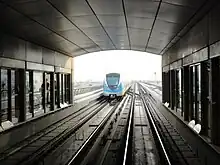
The Dubai Metro is operated by keolis under contract to the Roads & Transport Authority.[18] It has been renewed a number of times, most recently in March 2019.[30][31] In March 2021, the French-Japanese consortium of Keolis and Mitsubishi Heavy Industries was announced as a new operator from 8 September 2021.[32]
Red Line trains run every 5 to 7 minutes off-peak (averaging 8.5 trains per hour), with a minimum headway of 3 minutes 45 seconds (16 trains per hour) during peak hours, with 44 trainsets in service. Trains from the Red Line and Green Line can depart differently due to technical glitches. From 2010, when 51 trains were in service, the line had a peak-hour capacity of 11,675 passengers per hour in each direction. As of September 2014, the Red Line operates 60 trains (train registrations 5001–5045, 5065–5079) The theoretical maximum design capacity is 25,720 passengers per hour, which would require 106 trains.[33]
The Green Line had an initial capacity of 6,395 passengers per hour per direction, with 19 trains (train registrations 5046–5064) in service as of September 2014. The design capacity of this route is put at 13,380 passengers per hour with 60 trains in service.[34]
Ridership
Over 280,000 passengers used the Dubai Metro during the first week of its operation.[35]
Before launch, Dubai Municipality Public Transport Department expected the metro to provide transport for 12% of all trips in Dubai. After the first month of operation (on a limited network), the monthly total was 1,740,578 passengers, which equates to under 60,000 passengers/day.[36] After the opening of more stations in May 2010, ridership surged to 103,002 passengers/day and reached 130,000/day by the beginning of October 2010. When the Green Line opened on 9 September 2011, passengers on the Red Line was noted as 180,000/day. In 2013, passengers rose to 377,000/day, split 64% for the Red Line and 36% for the Green Line.[37] During the first half of 2015, RTA announced that 88,252,034 passengers have used the metro.[38] In August 2017, RTA announced that total ridership since 2009 had surpassed 1 billion total trips.
Statistics 2009 2010 2011 2012 2013 2014 2015 2016 2017 2018 2019 2020 2021 2022 2023 Lines 1 1 2 2 2 2 2 2 2 2 2 2 2 Kilometres 74.6 74.6 74.6 74.6 74.6 74.6 74.6 74.6 74.6 74.6 74.6 Trips (Red Line) 104,961 115,670 Trips (Green Line) 93,795 94,189 Trips (Total) 198,756 209,759 Passengers (Red Line) 6,892,544 38,887,718 60,024,794 71,914,000 88,886,539 104,000,000[39] 121,000,000[40] 121,600,000[41] 128,054,000[41] 132,400,000[42] Passengers (Green Line) 8,982,256 37,576,000 48,872,719 65,942,000[40] 69,708,000[40] 69,700,000[41] 72,021,000[41] 72,000,000[42] 70,612,933[42] Passengers (Total) 6,892,544 38,887,718 69,007,050 109,490,000 137,759,258 186,942,000[40] 190,708,000[40] 191,300,000[41] 200,075,000[41] 204,000,000[42] 202,978,067[42]
One issue for the new system was how to reliably and comfortably get riders to their final destination if it is not located near a metro station. The RTA has added "feeder bus routes" also known as Metro link buses. Seen in Blue and White. Which act as shuttle services to and from major locations in and around the station area. There are bus and taxi laybys constructed as well as drop off zones at each station for ease of passenger access.[43]
In addition 268 km of light rail lines are also planned, these will serve as feeders to the Dubai Metro. The Dubai Tram is one of the light rail plans.[43]
Signalling
To permit fully automated operation, Thales Rail Signalling Solutions is supplying its SelTrac IS communications-based train control and NetTrac central control technology. This is configured for a minimum headway of 90 seconds (40 trains per hour). The top speed of the trains is estimated to be around 95 km/h (59 mph), giving a round-trip time of 2 hours 23 minutes for the Red Line and 1 hour 23 minutes for the Green Line.[44]
Lines
Existing
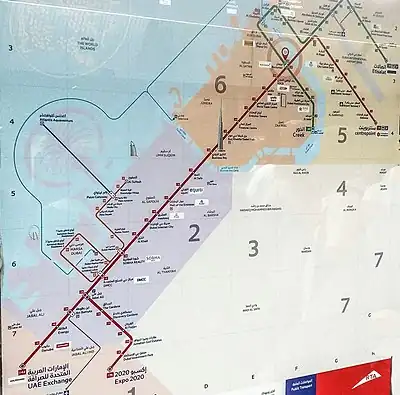
The first two lines of the Dubai Metro have 70 kilometres (43 mi) of lines, and 47 stations (nine of them being underground).[45] The red line stretches along the city from the Jebel Ali area to the border with Sharjah. It passes through several tourist attractions such as Mall of the Emirates, The Dubai Mall and Burj Khalifa. The green line, on the other hand, stays within the old Dubai area. It passes through many historical sites, such as the Dubai Museum, the Gold Souk, the Spice Souk among others. Because of that, many stations near those places are themed on the history of Dubai, with photos depicting the UAE in the 1960s or earlier being on display within the station. Some stations are even specially designed with the architecture of traditional Emirati houses, mirroring the architecture in the surrounding area.
Latest finished projects
Route 2020: A 15 kilometer (9 mi) extension with seven new stations (including two underground) already built which starts at the Jebel Ali Station and ending at the Expo 2020 Site.[46] Future plans will also extend this line to the Al Maktoum International Airport. The extension is served by new, redesigned trains from Alstom. The extension opened in stages in 2021.[47][48][49] Since Red Line trains now run directly on the new track to Expo 2020, the Red Line section from Jabal Ali to UAE Exchange is now run as a branch.
Summary of lines
| Lines | Terminals | Construction started | Opened | Newest Extension | Length km |
Stations | Trip time | Average speed | |
|---|---|---|---|---|---|---|---|---|---|
| Red Line | Centrepoint | Expo 2020 | 2006 | 2009 | 2021 | 67 | 31 | 55–75 minutes | 60-80 km/h |
| Jabal Ali] | UAE Exchange | 2006 | 2009 | 2021 | 14.3 | 5 | 11 minutes | 60-80 km/h | |
| Green Line | Etisalat | Creek | 2006 | 2011 | 2014 | 22.5 | 20 | 39–40 minutes | 60-90 km/h |
| Blue Line | Creek | Academic City | to start in 2024 | estimated 2029 | 21 | 10 | |||
| Centrepoint | International City | to start in 2024 | estimated 2029 | 9 | 4 | ||||
Proposed
In 2011, the RTA stated that there are no "immediate plans" to build the Blue and Purple lines "in the next five or six years". This is mainly because the planned area is empty and developing.[50]
In 2013, the RTA laid out a three-phase plan to expand the existing lines and build new ones: extending the Green Line by 12 stations and 24 kilometres (15 mi) to Academic City by 2020; expanding the overall system by 58 stations and 91 kilometres (57 mi) by 2025 and completing expansion with a total of 69 stations and 221 km over and above the present 47 stations and 70 kilometres (43 mi) that are present as of January 2013.
- Purple Line: along Al Khail Road (E44). The line will extend from the Al Maktoum International Airport to Muhaisnah, a locality near the border between Dubai and Sharjah.[51] There will be about eight stations, three with check-in facilities. However, The Dubai Airports Authority claimed that this was unfeasible as it did not pass through many localities. They however suggested opting for a "central terminal" similar to those in Europe where trains leave from inside the airport to the other airport with trains also leaving to the city. The RTA have taken this into consideration.
- Pink Line: The Pink Line is planned to run east–west with a terminus at Al Sufouh and is scheduled for completion by 2030.[52]
- Gold Line: Announced as the 'Yellow Line' in April 2008 and confirmed in January 2013 as the 'Gold Line'.[43] One of the stations planned for the Gold Line is the Dubailand Station, west of Meydan.[53] The Gold Line will connect Arabian Ranches, Deira, and Dubai Marina and is scheduled to open by 2025.[52]
- Red Line Extension: 15.5 kilometres (9.6 mi) and six new stations, terminating at the border with Abu Dhabi. No dates for completion announced.[54]
In 2014, the RTA approved the recent proposal of extending the Red Line from Al Rashidiya station to Mirdif City Center which will increase 3.5 kilometers with the new station. However, there is also a proposal to extend it further to Al Warqa’a which is currently being studied.[55]
On the Green Line, the RTA finalized the extension plan of 20.6 kilometers from Al Jaddaf to Academic City in 2014. The extension is due to go through Festival City, Lagoons, Ras Al Khor Industrial Area, International City, Dubai Silicon Oasis, and Dubai Academic City.[56] In November 2023, the Green Line and Red Line extensions eastward was approved under the Blue Line project of the Dubai Metro. [57]
In 2018, the engineering firm Aurecon produced a study into a 7.5 km express metro line from Al Qiyadah station on the Green Line till Sharjah.[58] The line would cost AED 3 billion, and could reduce traffic congestion between the two cities by up to 30%.
Stations


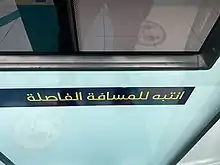

Dubai Metro is composed of at-grade (G) elevated Type 1, Type 2 and Type 3 (T1, T2 and T3, respectively) underground stations (U) and underground transfer station types (UT). Type 1 is the regular at-grade concourse station, Type 2 is a regular elevated concourse station, and Type 3 is an elevated special track station with an extra track to hold a non-operational train. Underground transfer stations accommodate both the Red and Green lines for easy transfers.[33]
Besides these differences, there are five themes used in the interiors of the stations:[59] The red line individually has 29 stations including the Interchange Stations between Green Line. The green line has 20 stations including the Interchange Stations between Red Line. Route 2020 (Connected with the Red Line from Jebel Ali) individually has 7 stations in total (including Jebel Ali; 6 without it).
Inside the stations will have air conditions from 24 to 21 Celsius.
- Heritage: Symbolizes the culture and history of the United Arab Emirates.
- Earth: Marks the start of the Dubai modern and urban drive, which resembles the force and durability of earth and soil.
- Air: Symbolizes the elation and joy that Dubai provides to residents and visitors.
- Fire: Symbolizes the energy, vigour and strong will displayed by Dubai leaders.
- Water: Symbolizes the human values which Dubai seeks to ensure in its modern achievements.
The Earth stations have a tan-brown colour effects; water has blue-white colour effects; fire has orange-red colour effects; and the air has green colour effects.[60][61]
Officials have negotiated with international and local companies over naming rights for 23 stations on the two lines. This corporate branding is the first of its kind.[62] Some examples are: BurJuman, Burj Khalifa/Dubai Mall, Mall of the Emirates, DAMAC Properties and UAE Exchange.
Most stations have a ZOOM market inside.
Parking
The Dubai Metro has built three large multi-level car parking with an estimated capacity to accommodate more than 8,000 vehicles for the passengers where they can park their car and ride the metro.
| Stations | Line | Spaces |
|---|---|---|
| Centrepoint (Rashidiya) Metro Station | Red Line | 2700 cars |
| Jabal Ali Metro Station | Red Line, Branch | 3000 cars |
| Etisalat by e& Metro Station | Green Line | 2300 cars |
| Jumeirah Golf Estates Metro Station | Red Line | 400 cars |
The parking is free for the metro users.
Handicapped facilities
All metro stations have elevators and contrasting tactile guidance path to guide the visually impaired. There are also dedicated spaces for wheelchair users on all the trains. Handicapped passengers, also known as 'people of determination' in the UAE, can ride with any RTA service for free with a special, personalized Nol Card.
Safety
Emergency stop buttons, intercoms and platform screen doors with corresponding flashing light signals are installed at every station for the safety of the passengers. Trains are equipped with emergency stop buttons, door release levers, intercoms and fire extinguishers. CCTV is operational throughout the entire network and in trains and police officers are regularly on patrol in the stations, especially during rush hours.
Telecommunication
Wi-Fi connectivity is available across all trains and stations and is provided by du which is in par with the Wi-Fi UAE program which provides Wi-Fi connectivity across major parts of UAE. Mobile phone coverage is available across the entire network of the metro. The metro itself has Wi-Fi connectivity inside for the commuters to access with two tiers of Internet access with the normal service being free whereas the premium service can be accessed by a nominal fee.[63]
Travelling
The Dubai Transport is divided into 4 tiers (5 zones). The prices were slightly increased as of 11 November 2014.[64] The cheapest ticket (not preloaded, and not in the "gold" class) with a distance not more than 3 km cost 3 AED (about $0.82) – the equivalent of Tier 0, and most costly single trip (Tier 3, exceed 2 zones, and paper not preloaded ticket also) 7.5 AED (about $2.04) and was not increased from opening. Tier 1 is one zone trip, where the travel exceeds 3 km, Tier 2 is neighbouring 2 zones travel. Also (excluding Gold class) using cards there is "no more paying" – a free rest of day travel if the cost exceeds 14 AED (about $3.81).[65][66]
Ticketing
The Dubai Metro has a fixed fare based on three tiers and travelling under 3 km costs 3 AED.[67] The tiers are:
| Tiers |
|---|
| Tier 1 |3 AED| Within 1 zone start and end in same zone |
| Tier 2 |5 AED| Starts in 1 zone and ends in neighboring zone |
| Tier 3 |7.5 AED| Crosses 3 or more zones |
The Nol Card are used by the passengers to check-in and check-out at the gates in their destination station. No other payment form (cash, credit card) can be used. The fare will be automatically deducted based on the number of zones traveled. Passengers will be allowed to check-in when their card has more than minimum credit required.
Children below the age of 5 years or less than 90 cm and people with disabilities (personalized Nol Card required) will be eligible to travel the metro for free.
There is also a Nol Card available for students & seniors, and they can get a student & senior citizens' discount.
Rolling stock
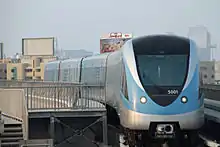

Japanese manufacturer Kinki Sharyo built a total of 79 five-car trains (60 on Red Line, 19 on Green Line).[68] They are designed to carry 643 seated and standing passengers, and unusually for a mass transit system, the trains have three classes of accommodation: Gold Class (first class), Women and Children class, and regular Silver Class (economy).[69] The first train (5001) was delivered to Dubai in March 2008.[68] The trains are driverless, use third rail current collection. Trained wardens accompany passengers to help with emergencies.[70] The four newer trains (5074, 5075, 5076, and 5077) are each painted with a different special livery, in which one of them (train 5077) representing the skyline of Dubai.[71]
50 new trains, the Alstom Metropolis, were introduced in November 2018.[72] The trains have higher capacity, 696 passengers, up from 643 passenger on the current trains.[73] This will increase passenger capacity by about 10%. The new trains have a refreshed interior with better air conditioning, digital maps, improved speed, brakes and doors.[72] Out of these 50 trains, all 50 are running on the Red and Green Lines.
Culture
Music Festival
Brand Dubai collaborated with Roads & Transport Authority back in March 2019 to launch the "Dubai Metro Music Festival", there was no festival in 2020 and 2021 because of COVID-19. It is held from 14 to 20 Sha'aban every year. Held across red line stations.
| Year | Stations | Dates | Timings | Musicians | Nationalities | Instruments |
|---|---|---|---|---|---|---|
| 2019 | Union, BurJuman, Burj Khalifa / Dubai Mall, Mall of the Emirates, DMCC | March 17-23, 2019 | 6am-12pm (Union, BurJuman, Mall of the Emirates and DMCC), 12-4pm (Burj Khalifa / Dubai Mall) | Aksana Laukava, Vineet Panchal, PorcaPizza | Belarus, India, Italy | Saxophone, Tabla, Recycled One Man Band |
| 2020 | None because of COVID-19 | |||||
| 2021 | None because of COVID-19 | |||||
| 2022 | Union, BurJuman, Mall of the Emirates, Jabal Ali, Expo 2020 | March 16-22, 2022 | 4-10pm | Inass Halal, Christophe Servas, Al Taj, Jose Luis Torres | Syria, France, Egypt, Ecuador | Percussion, Flute and Recycled Instruments, Flute Beatbox, One Man Band |
| 2023 | Union, BurJuman, Financial Centre, Mall of the Emirates, Sobha Realty | March 6-12, 2023 | 4-10pm | John Buttigieg, Anetta Morozova, Isabelle Clarençon | Australia, Russia, France | Guitar, Flute, DJ and Piano |
Guinness World Record
On 1 November 2018, as part of the RTA's Public Transport Day, the longest diverse human chain of hand was formed in a Dubai metro train at Etisalat station.[74] The record was acknowledged by Guinness World Records. The chain was formed by people from 96 countries around the whole world. Previously this record was with Norway, where 75 nations made a diverse human chain.[74]
Dubai Metro Museum
Sheikh Mohammed bin Rashid Al Maktoum, Vice President and Prime Minister of the UAE and Ruler of Dubai, gave his directions to transform Dubai Metro stations into art museums under the supervision of Dubai Culture and Arts Authority, The project was announced early April 2014 and aims at displaying contemporary and modern art.[75]
Incidents and accidents
- 10 September 2009: one metro train broke down and passengers were stranded for two hours before being picked up by a second train.[76]
- 28 February 2010: Thousands of commuters were affected after part of Dubai Metro's Red Line was closed after a small fire on the track. A section of the Red Line between Al Jafiliya Station near Za'abeel Park and Terminal 3 Station was shut at around 7 pm and remained closed until Monday morning. Trains were evacuated at Burjuman (formerly Khalid Bin Al Waleed), Union Station and Al Rigga Station. A Dubai Roads and Transport Authority (RTA) spokesman confirmed there was smoke on the underground track between Union and Burjuman Station. However, RTA officials remained tight-lipped about what had caused the incident.[77]
- 25 December 2011: Passengers reported that some trains stalling and others moving 'at snail’s pace' due to technical problems. The RTA confirmed that both the Red and Green lines of the metro were running slow, in both directions, due to "some technical issues".[78]
- 3 December 2012: The Dubai Metro saw its first death when a man committed suicide by lying down on the metro tracks and was run over by the automated train.[79]
- 12 August 2014: Commuters on a segment of the Dubai Metro’s Red Line were stranded after a train (registered 5075) stopped between Al Karama and Al Jafiliya stations during peak hours following a technical snag at around 7 pm. According to a Roads and Transport Authority (RTA) official, the train on the Red Line experienced an electrical failure, causing the metro to stall operations between the Union and Business Bay metro stations leaving 2000 passengers stranded. The Green Line operated as usual. The passengers stranded in the train broke the emergency door using the hammer and opened the door as there was no air conditioning available and walked to Al Karama Metro Station by walking on the viaduct. Two hours later, the Metro services were fully restored.[80]
- 29 October 2014: In late evening, commuters on the Dubai Metro were stranded at stations due to trains between Business Bay station and Nakheel station stopped operating in both directions due to a technical glitch. The systems were fully restored one hour later.[81]
- 3 April 2016 – Passengers were left stranded during evening rush hour after a technical snag delayed train services on the Red Line. Systems were restored in 30 minutes.[82]
- 24 August 2017 – A man commits suicide in Noor Bank Metro Station. The station was shut down for one hour following the incident.[83]
- 6 November 2017 – Passengers commuting on the Red Line were left stranded after a technical glitch caused train services to temporarily stall specifically near Jumeirah Lakes Towers (now DMCC) and UAE Exchange stations. Services returned to normal at 12:32 PM.[84]
See also
References
- ↑ "Specifications: Dubai Metro – Most Advanced Urban Rail Systems". Railway-Technology.com. Archived from the original on 7 September 2011. Retrieved 14 September 2009.
- ↑ "New Dubai Metro operator looks to take public transport to next level". The National. 9 September 2021. Retrieved 3 January 2022.
- ↑ "Roads & Transport Authority, UAE".
- ↑ "Designers transfer Hong Kong know-how to Dubai's new metro". scmp.com.
- ↑ "Al Ghurair :: Metro Milestones". Archived from the original on 27 October 2014.
- ↑ "Dubai Metro Opens on Time But Over Budget". Sky News. 9 September 2009. Archived from the original on 12 September 2009.
- ↑ "Dubai metro unlikely to speed business growth". Ameinfo. 8 September 2009. Archived from the original on 9 September 2009.
- ↑ "Will metro change Dubai car culture?". BBC News. 11 September 2009.
- ↑ "TheNational.ae".
- ↑ "Home". Archived from the original on 28 December 2014. Retrieved 26 February 2010.
- ↑ "Dubai Metro". atkinsglobal.com. Archived from the original on 13 March 2017. Retrieved 27 March 2017.
- ↑ "Construction of Dubai Metro extension a feat of engineering | The National". Retrieved 27 March 2017.
- ↑ "Dubai in Guinness for longest driverless metro". Khaleej Times. Archived from the original on 28 August 2014. Retrieved 19 March 2022.
- ↑ "Longest driverless metro line". Guinness World Records. 23 May 2011. Retrieved 26 April 2017.
- ↑ Staff Report (14 November 2020). "RTA projects make Dubai traffic freer than leading cities with similar population". Gulf News.
- ↑ Final Bidding Underway In Dubai International Railway Journal November 2004 page 10
- ↑ Dubai Takes On 100% Of LRT Financing International Railway Journal February 2005 page 9
- 1 2 Dubai metro contract awarded Archived 17 September 2009 at the Wayback Machine Railway Gazette International 1 July 2007
- ↑ "Jebel Ali Free Zone". Business-Dubai.com. Archived from the original on 17 November 2015. Retrieved 26 November 2015.
- ↑ Dubai RTA – Red Line Project Archived 9 August 2009 at the Wayback Machine as on 2007-09-09
- 1 2 "Ten key Dubai Metro stations set for launch". Gulf News. 30 August 2009. Archived from the original on 1 September 2009.
- ↑ "UAE Vice President launches Dubai Metro". Gulf News. 9 September 2009. Archived from the original on 13 September 2009.
- ↑ "Changes to Metro put cost up by Dh12bn". The National. UAE. 31 August 2009.
- ↑ "Work begins on Dubai Metro project". Khaleej Times. 22 March 2006. Archived from the original on 26 October 2014. Retrieved 23 March 2006.
- ↑ "Dubai Metro on track despite global crisis". Arabian Business. 2 January 2009. Retrieved 6 February 2009.
- ↑ Staff Report. "RTA sets date for Jebel Ali Metro Station opening". Gulf News.
- ↑ Ahmed, Ashfaq (15 October 2010). "Five new stations open on Red Line of Dubai Metro". Gulf News.
- ↑ Shabandari, Muaz (12 December 2012). "Danube metro station unveiled". Khaleej Times. Archived from the original on 13 December 2012. Retrieved 12 December 2012.
- ↑ "Dubai Metro fully functional; Al Jadaf, Creek stations open to public". Khaleej Times. 2 March 2014. Archived from the original on 18 March 2014. Retrieved 2 March 2014.
- ↑ keolis signs Dubai Metro contract extension Metro Report International 1 April 2019
- ↑ RTA renews Dubai Metro O&M Contract with keolis ME Construction News 1 April 2019
- ↑ Ahmed, Ashfaq (20 March 2021). "RTA changes company for Dubai Metro and the tram operations and maintenance". Gulf News. UAE.
- 1 2 "Dubai Metro Network". Railway Technology. Archived from the original on 13 April 2005.
- ↑ Ellis, Dominic (27 March 2008). "Driverless trains to support a prosperous future". Railway Gazette International. Archived from the original on 15 September 2009. Retrieved 28 December 2008.
- ↑ "World's Longest Automated Unmanned Metro Opens in Dubai". Pravda.ru. 24 September 2009. Retrieved 23 September 2009.
- ↑ "Dubai Metro lifts 1.7m passengers in first month". Arabian Business. Archived from the original on 17 July 2010. Retrieved 13 October 2009.
- ↑ RTA Annual Statistical Report, UAE: RTA, 2013
- ↑ Wam. "88m use Dubai Metro, 2m use Tram in H1 2015". Khaleej Times.
- ↑ "Revealed: How many passengers used Dubai Metro in 2014". Archived from the original on 18 May 2015. Retrieved 12 May 2015.
- 1 2 3 4 5 Staff Report (9 September 2017). "One billion riders used Dubai Metro in eight years". Gulf News. Retrieved 11 August 2018.
- 1 2 3 4 5 6 "1.51 million use Dubai public transport daily". Gulf News. Retrieved 29 December 2018.
- 1 2 3 4 5 "Revealed: Dubai's most popular public transport; 589 million commuters in 2018". Khaleej Times. Retrieved 6 November 2019.
- 1 2 3 "Blue and Purple Lines unlikely in next five years". Railway-Technology.com. Retrieved 18 September 2011.
- ↑ "Dubai Metro Network". Railway Technology. Verdict Media Limited. Retrieved 14 May 2019.
- ↑ "Shaikh Mohammad tours the Dubai Metro project". Gulf News. 8 November 2007. Archived from the original on 28 December 2007. Retrieved 22 December 2007.
- ↑ "Dubai Metro's Red Line to get seven new stations for Expo 2020". The National. 11 April 2015. Retrieved 6 June 2021.
- ↑ "Photos: Dubai Investment Park, Expo Stations on Dubai Metro Route 2020 are now open". gulfnews.com. June 2021. Retrieved 6 June 2021.
- ↑ "Dubai Metro: Two new stations open today". www.zawya.com. Retrieved 6 June 2021.
- ↑ Sircar, Nandini. "First look: 2 new swanky Dubai Metro stations open". Khaleej Times. Retrieved 6 June 2021.
- ↑ "Blue and Purple Lines unlikely in next five years". Arabian Supply Chain. 11 September 2011. Archived from the original on 20 March 2012. Retrieved 13 September 2011.
- ↑ "Dubai Metro". Dubai Online. 11 March 2020.
- 1 2 Dubai metro expansion plans Railway Gazette International 30 September 2014
- ↑ Al Zarooni, Mustafa (17 January 2013). "Dubai Metro on expansion track". Khaleej Times.
- ↑ "Dubai Metro Green Line set to start mid-2010". Arabian Business.
- ↑ Shahbandari, Shafaat (13 September 2014). "Dubai Metro expansion latest: Red Line to Al Warqa'a". Gulf News. Retrieved 12 May 2019.
- ↑ Shahbandari, Shafaat (13 September 2014). "Dubai Metro expansion latest: Red Line to Al Warqa'a?". Gulf News.
- ↑ https://www.geplus.co.uk/news/dubais-metro-blue-line-project-gets-go-ahead-28-11-2023/
- ↑ "Here's what a Dubai–Sharjah metro link could mean". Gulf News. 27 January 2018. Retrieved 23 November 2020.
- ↑ "Dubai metro themes". Gulf News. 1 September 2009. Archived from the original on 17 November 2015. Retrieved 11 August 2015.
- ↑ Dubai Rapid Link Consortium – Approved Red Line Project Model dtd. 5 Nov. 2006
- ↑ Dubai Rapid Link Consortium – Approved Green Line Project Model dtd. 19 Nov. 2006
- ↑ "Is Advertising the New Indicator for Emerging Markets?". Contrarian Profits. 11 August 2008. Retrieved 12 August 2008.
- ↑ Leijen, Majorie van (13 July 2015). "Dubai Metro WiFi: All you need to know".
- ↑ Shahbandari, Shafaat (5 November 2014). "RTA revises public transport tariff". Gulf News.
- ↑ "Dubai Metro-Dubai Metro Tickets". 7 August 2011.
- ↑ "Dubai public transport a popular ticket in 2017". The National. UAE.
- ↑ "Dubai Metro – Information, Route Map, Fare & Timings". The Metro Rail Guy. Retrieved 11 May 2020.
- 1 2 First Dubai metro train arrives Archived 4 January 2010 at the Wayback Machine, Railway Gazette International 2008-03-14, retrieved 2008-03-15.
- ↑ "At a glance:Dubai Metro". Gulf News. 19 March 2007. Archived from the original on 1 June 2008. Retrieved 30 May 2008.
- ↑ "Trained wardens will help people on Dubai Metro". Khaleej Times. 16 April 2007. Archived from the original on 26 October 2014. Retrieved 19 March 2022.
- ↑ "Metro trains in Dubai get artistic makeover in the Art Metro project". The National. 5 May 2015. Retrieved 25 June 2016.
- 1 2 "First of new Dubai Metro trains to arrive in November". Gulf Business. 23 September 2018. Retrieved 3 November 2018.
- ↑ Staff Report. "Photos: Dubai Metro to get first of new trains this year". Khaleej Times. Retrieved 3 November 2018.
- 1 2 Saseendran, Sajila (1 November 2018). "Watch: Dubai Metro users set record for most diverse human chain". Gulf News. Retrieved 3 November 2018.
- ↑ "Dubai Metro stations to be art museums". 17 March 2014. Retrieved 15 June 2015.
- ↑ Gulfnews.com Archived 12 September 2009 at the Wayback Machine
- ↑ Ahmed, Ashfaq (2 March 2010). "Fire breaks out on Metro track". Gulf News.
- ↑ Staff (25 December 2011). "Technical snag forces Dubai Metro to go slow". Emirates 24-7.
- ↑ "Man killed on Dubai Metro in apparent suicide, say police". The National. 5 December 2012. Retrieved 22 January 2013.
- ↑ Shahbandari, Shafaat (12 August 2014). "Dubai Metro stops between stations, passengers stranded". Gulf News.
- ↑ Staff Report. "Dubai Metro's Red Line 'back to normal' after glitch". Khaleej Times. Archived from the original on 29 October 2014. Retrieved 29 October 2014.
- ↑ Maceda, Cleofe (3 April 2016). "Passengers stranded at Dubai Metro station". Gulf News. Retrieved 4 April 2016.
- ↑ Achkhanian, Mary (23 August 2017). "Man reportedly dies at Dubai Metro station". Gulf News.
- ↑ Al Serkal, Mariam M.; Shahbandari, Shafaat (6 November 2017). "Dubai Metro service interrupted during Monday morning rush hour". Gulf News.